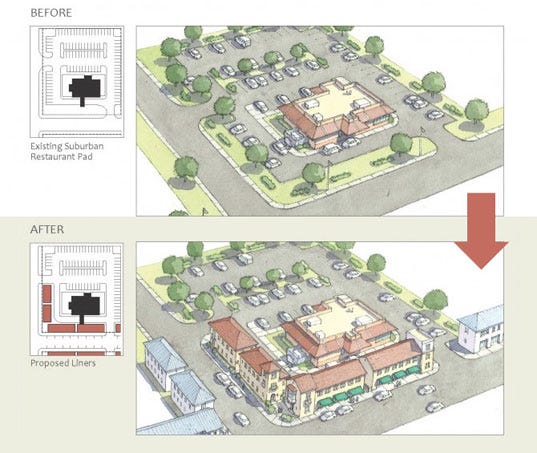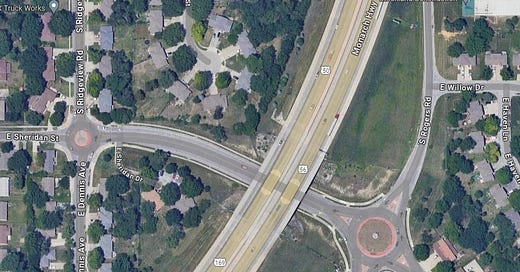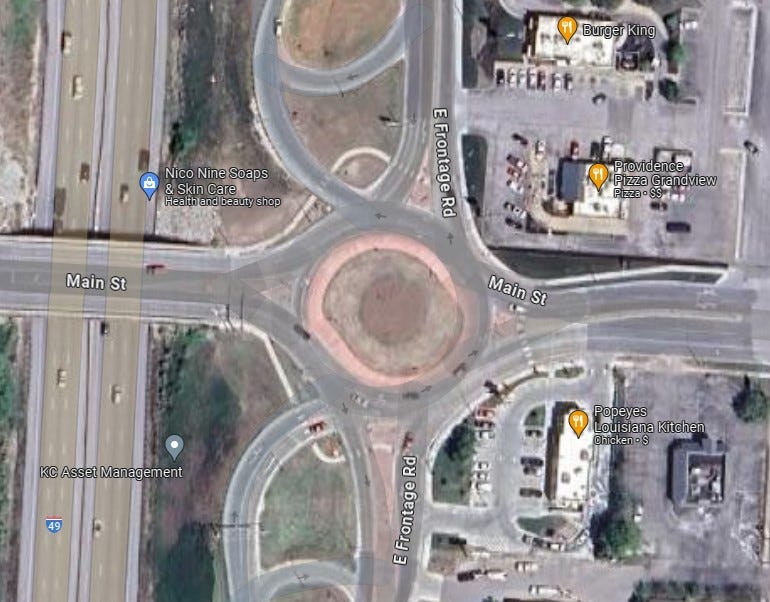Yes, Roundabouts Really are a Great Solution
My case for why we need vastly more roundabouts, everywhere
Not another piece on roundabouts! Hang in there, and I’ll show why this really matters to communities all over our country.
It’s no secret I’ve been a fan of roundabouts as an intersection design solution for many years. I helped design some for various projects that have been built, and I’ve written about their benefits here.
My friend Andy Boenau, over at Urbanism Speakeasy, recently wrote an excellent post about how roundabouts can help retrofit suburbia. I loved what he wrote, and promised him I’d elaborate in this space some ideas that I’ve kicked around for years. So here we are.
I’m going to just start right out by saying it’s my belief roundabouts should be used at 80% of major intersections in America. What’s funny, is this puts me at odds with so many people:
People who are happy with suburbia just as it is, and don’t want it to change
Traffic engineers that are stuck in decades-old practices
People who drive that are just scared of roundabouts generally
Hardcore urbanists, who think roundabouts are over-used and not pedestrian friendly
With so many different kinds of people lined up against me, I feel even stronger that this approach is correct.
Broadly speaking, I’d like to address two different groups that have opinions about American-style suburbia:
Group 1: I love suburbia and don’t really want it to change
If you’re in this camp, here’s the thing: you still have to deal with and think about traffic. And, your city government still has to pay for roadways and maintenance.
Roundabouts flat-out move traffic more smoothly than signals, and they do it far safer. So, your traffic will actually flow just fine, and fewer people will die or get hurt at big intersections. I’d hope that most people consider that a win-win.
For your local government, roundabouts have far, far lower lifetime costs than signals. First off, buying new signals is not cheap. For a large intersection, the kind we have in most of suburbia, they can be very expensive. What’s more, they have to be maintained, upgraded and replaced in a predictable cycle. They also have a tendency to fail, and can truly disrupt traffic patterns when that happens.
Roundabouts *might* have a higher first-cost. I’ve seen it stated they can be expensive compared to signals, but that’s not been my experience as a designer. Partially, I think it’s because some engineers over-design the roundabouts, and make them too big. As they grow, they grow in expense obviously.
But even after installation, the life-cycle costs are low. Essentially, you have some maintenance costs for whatever is in the circle, and that’s really it. Sure, curbs and pavement will have to be replaced on a normal cycle, but that has to happen no matter what is done.
I haven’t run the numbers – I wish someone would for me – but I suspect for many local governments you’re looking at really big long-term savings that have a direct impact on taxation levels and/or municipal budgets.
Group 2: These are the weirdos like me that think suburbs can and should evolve into something more like traditional human settlements. That is, neighborhoods, cities, towns that also make it pleasant to move around on foot or on bike. It’s a crazy idea, I know, that humans shouldn’t be dependent on a machine to be able to buy a gallon of milk or go see other humans in public.
This is something Andy addressed well in his piece below, but I want to add an important element of color to it. A key quote from Andy:
Sprawl won't be repaired overnight. But converting bloated corridors with giant signalized intersections is worth fighting for. Think of all that extra space that could be used for shared-use paths separated from the car traffic! It boils down to a geometry challenge, and those can be fun. Use a visualization tool like Streetmix to come up with layouts.
I measured one suburban road that was 150' wide from back of sidewalk to back of sidewalk. Then I recreated what it looks like today. If the alternative corridor had roundabouts on either side instead of signals, you wouldn't need those turn lanes. The intersection itself would bulb out, but the corridor would be more like this, giving you 90' to play with.
Intersections are the key to traffic design. Intersections are where traffic backs up and delays. Roadways are often designed with extra lanes (as engineers say, more capacity), simply to allow for stacking up of cars at intersections.
If traffic at intersections can be more reliably handled, as I believe they can by roundabouts, then it opens up wide the opportunity to do “road diets” on large, major streets.
Ultimately, this is the key to what people call sprawl repair or retrofitting suburbia. The major streets and their designs are what are preventing evolution in a more humane fashion. No developer in their right mind wants to “front” a stroad that’s 150 feet wide, with fast-moving traffic and zero people walking around. No amount of planning requirements forcing buildings to front onto those streets make this any better.

The streets themselves must be fixed. And the best way to fix them is by fixing the intersections.
Imagine a series of roundabouts on a corridor. The need for 6 lanes becomes 4, or 4 becomes 2. What now can you do with all the extra land area, which was devoted to concrete roadways and roadside drainage?
Here’s some ways to fill that void:
Shared paths / bike lanes
Parking lanes
Trees and landscaping
Any or all of those options actually create a space where people want to be, which means it’s then more desirable to flip your buildings around. Instead of facing the parking lots, they now might want to face the street.
Voila! You’ve created something much more desirable for actual humans, and it’s safe to have your ten year old ride a bike to the store now.
Look, there’s no silver bullets with anything. But often we make everything overly complex. For so much of our country, roundabouts are a plainly obvious improvement.
We have a very car-dominated built landscape, even in most of our “urban” communities. That’s probably not changing anytime soon, if ever. Let’s understand our cities are not European, while working to make them more humane, beautiful and accessible for all. Roundabouts can help tame the stroad and traffic monster, can ease some pain on municipal budgets, and can help point toward a future with better walking and biking options. Sometimes the solution really is as obvious as a big circle.







I agree with everything in this post, and ending it with a reference to an underrated Coen brothers movie is sweet.
I’m with you—except I don’t trust American civil engineers not to f’ it up! We need a new profession of transportation engineering